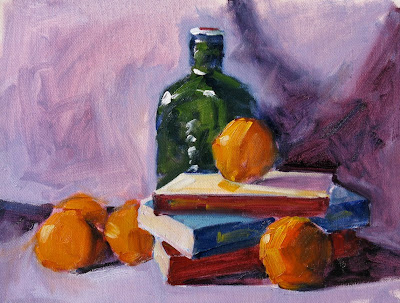 On this cold and blustery night at class I had something warm and comforting on my mind: Soup and another look at PERSPECTIVE - in cylindrical objects. The red jar and the soup can are slightly below our eye level so the tops appear as shallow ellipses - not too hard. Hmm . .
On this cold and blustery night at class I had something warm and comforting on my mind: Soup and another look at PERSPECTIVE - in cylindrical objects. The red jar and the soup can are slightly below our eye level so the tops appear as shallow ellipses - not too hard. Hmm . . Those stacked bowls however, YIKES! Every painter in the room struggled to make them nest and appear correctly in perspective. We were concentrating too much to even whine.
One key to drawing success here would be to establish the axis of each ellipse then refine the shape and direction by comparing the positive shapes against the negative shapes - almost like the shapes were 2 dimensional jigsaw puzzle pieces. If we train our eyes to see and correctly fit together those shapes the result will appear 3 dimensional.
Knowledge of PERSPECTIVE is important to show spacial depth in a drawing but sometimes we can get a better result by throwing out what our brain thinks it KNOWS and trusting our eyes.
Now, what about those darn crackers?

